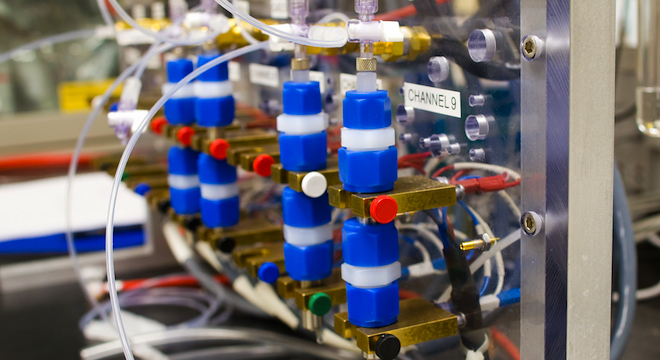TINA CASEY
Back in 2009, tech giant IBM missed out when the Department of Energy distributed a record $2.9 billion in research grants to develop low cost, high range batteries for electric vehicles. Now the company seems determined to leapfrog over DOE with its own pet project, called the Battery 500 Project.
Battery 500 is just what the name says: a vehicle battery that can take you 500 miles between charges, equal to or better than a typical tank of gas.
Conventional lithium-ion batteries are the gold standard for vehicle batteries, but so far their range is limited by energy density; in other words, they don’t have the capacity to store a lot of energy within the confined space of a passenger car. Packing more capacity into a small, lightweight and inexpensive form is the key next-generation technology.
According to IBM, the solution is a lithium-air battery, a key component of which is on — just what the name says — air. Ambient oxygen in the air reacts with carbon in the battery to create an electrical charge. IBM notes that the energy density of a lithium-air battery is ten times that of lithium-ion.
The groundbreaking technology is shown off in the following video simulation:
It sounds too good to be true, and so far, it has been. Initial lithium-air battery prototypes that have been developed by other teams of researchers are highly unstable, potentially explosive and have a very short lifespan.
To tackle this problem, IBM kicked off Battery 500 in 2009 under the leadership of in-house researcher Dr. Winifried Wilcke. It got off to a slow start but things started cooking when Wilcke and his team realized that there were two reactions going on in lithium-air batteries: one between the oxygen and the carbon, and another, previously unobserved reaction between oxygen and the electrolyte solution that carries the charge between electrodes.
The electrolyte solution was a carryover from lithium-ion technology, but apparently it is the source of instability in lithium-air technology.
And so, the search was on for an alternative electrolyte. In January, the news broke that Wilcke’s team had found the answer, but so far IBM is staying mum on its identity.

Nevertheless, it appears that a breakthrough has occurred, because on Thursday, IBM announced that it has added the Japanese company Central Glass to the Battery 500 team. The company is known for its work on lithium-ion batteries and will help IBM develop a new class of electrolytes for lithium-air batteries.
IBM also appears to be moving forward on another key obstacle to lithium-air success, which is the high sensitivity of lithium to steam and atmospheric carbon dioxide (aka humidity).
Thursdsay’s announcement also included the news that Battery 500 is taking on another leading Japanese company with experience in lithium-ion batteries, Asahi Kasei, which specializes in innovative membrane technology.
Concerning IBM’s race against the DOE, if anything it’s a friendly competition. Although IBM did not receive grants in the 2009 round of funding dedicated to advanced electric vehicle research, the company is a long-time federal research collaborator.
That partnership has factored heavily into the ability of Battery 500 to move forward, since Wilcke’s team conducted its research on electrolytes at DOE’s Argonne National Laboratory, using a petaflop IBM BlueGene/P supercomputer.
In any case, IBM cautions that its lithium-air technology will not be available commercially until at least 2020, and possibly not until 2030.
Until then, car buyers can avail themselves of DOE-funded technology that is coming into the market through the agency’s Vehicle Technologies Program.
The highly regarded (Motor Trend Car of the Year) Chevy Volt can trace its battery roots back to the program, which is also responsible for creating analytic tools that are used by scores of companies around the world to develop new electric vehicle technologies.









